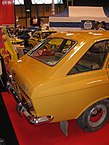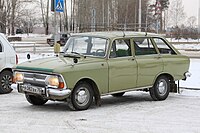Izh 2125
| Izh 2125/21251 Kombi | |
|---|---|
Small family car | |
| Body style | 5-door hatchback |
| Related | Izh 412 Izh 2715 |
| Powertrain | |
| Engine | UZAM 412 |
| Chronology | |
| Successor | Izh 2126 |
The Izh 2125 "Kombi" (
The Kombi was a notable sales success within the USSR between 1974 and 1980 due to its durability, off-road capability, and increased carrying capacity.[2] It was the first Izh car sold for export.[3] Its popularity was also helped by limited competition – station wagon variants of the Lada, Moscow-built Moskvitch, and Volga were in short supply and not as easy to buy as the Kombi. In 1982, the Kombi received a facelift, along with the IZh-produced Moskvitch-412 and Izh 2715 panel van and was then rebranded as the 21251.[1] Among notable features improved seats and headrests.
The modernised Izh 2125 sold into the 1990s. As the Soviet Union collapsed, IZh was first privatized as the open joint stock company "Izhevsk" and slowly started converting their automotive production lines to other kinds of manufacture, such as
Kalashnikov CV-1
On August 23, 2018, the arms manufacturer Kalashnikov presented an electric car with exterior design closely based on that of the Izh 2125.[4] The range on one charge was claimed to be 350 km, but nothing else was ever heard of this.
Gallery
-
Rear view. The rear was identical on all models
-
Pre-1982 Izh-2125, showing a metallic grille similar to that of the 412
-
Post-1982 Izh-2125, with recessed door handles
-
Post-1982 (21251) grille, where the outline was removed and the metal elements painted black
References
- ^ a b IZh-2125, "Avtolegendy SSSR" Nr.54
- ^ "Izh Kombi" (in Russian). Archived from the original on 2016-03-06. Retrieved 2015-10-27.
- ^ "Izh-2125 / 21251 "Kombi" (Moskvitch-412)" (in Russian).
- ^ "Kalashnikov takes on Tesla with retro-look electric 'supercar'". 23 August 2018.
- IZh-2125, "Avtolegendy SSSR" Nr.54, DeAgostini 2011, ISSN 2071-095X (in Russian)




